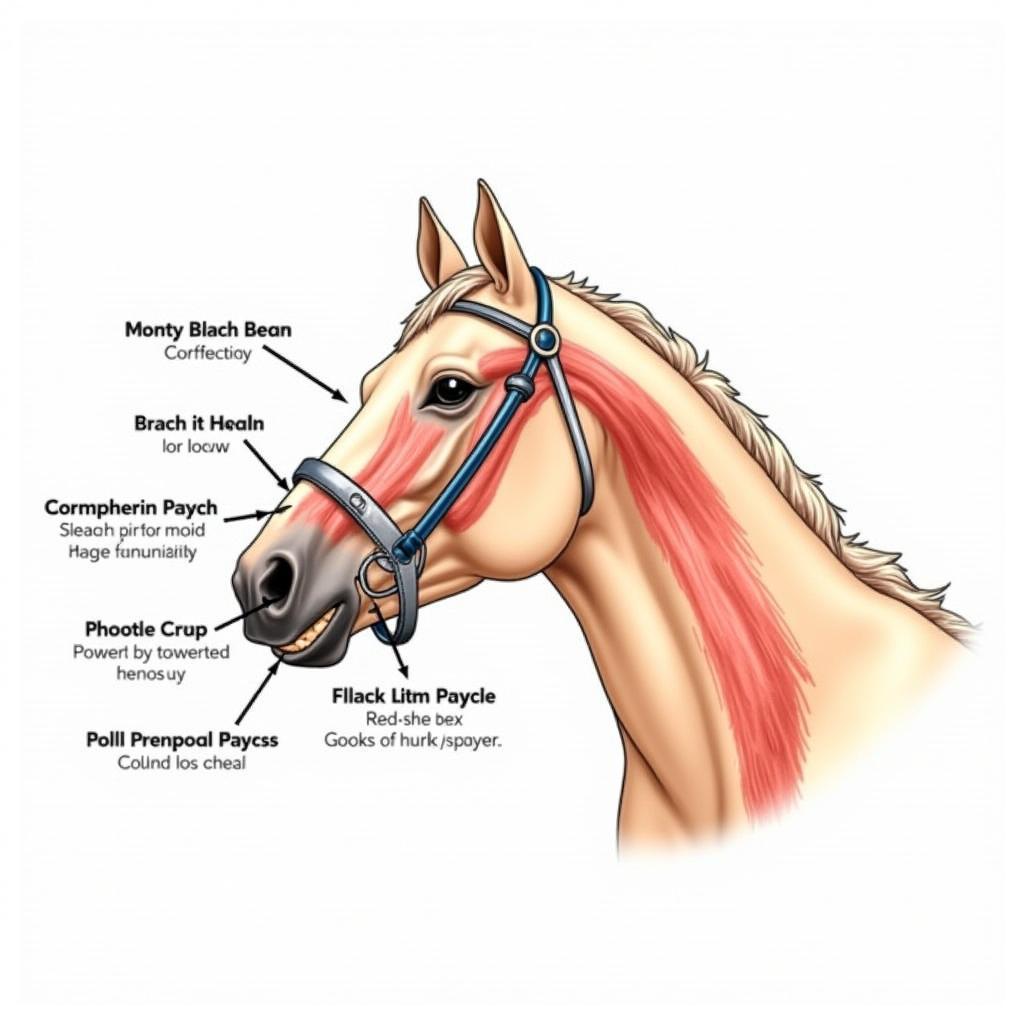Horse Bit Parts are crucial to effective communication between horse and rider. Understanding the various components of a bit, their function, and how they impact a horse’s mouth is essential for any equestrian. Choosing the right bit and using it correctly ensures a comfortable and responsive ride while promoting the horse’s well-being.
Decoding the Anatomy of a Horse Bit
A horse bit, seemingly simple, comprises several interconnected parts, each playing a specific role in its overall function. Let’s break down these key horse bit parts:
- Cheekpieces: These are the side pieces that attach to the bridle’s cheek straps and determine the bit’s action and lateral movement. Different cheekpiece designs, such as D-rings, eggbutts, and full cheeks, offer varying levels of control and stability.
- Mouthpiece: This is the central part of the bit that rests in the horse’s mouth. Mouthpieces come in various materials (stainless steel, sweet iron, copper) and shapes (single-jointed, double-jointed, mullen) influencing pressure distribution and palate contact.
- Rings/Loops: These are connected to the mouthpiece and attach to the cheekpieces. The size and shape of the rings affect the bit’s action and the amount of pressure applied to the bars of the mouth.
- Joints: Some mouthpieces have joints, which can be single or double, impacting the way the bit applies pressure and folds within the horse’s mouth. A single-jointed bit creates a nutcracker effect, while a double-jointed bit is generally considered gentler.
How Horse Bit Parts Influence Communication
The interplay of these horse bit parts determines how pressure is applied to the horse’s mouth, influencing communication and control. Choosing the right combination of cheekpieces, mouthpiece, and rings is crucial for effective and humane riding. For example, a full cheek bit provides lateral stability, ideal for young horses or those needing directional guidance. Conversely, a loose ring snaffle offers more movement and is suitable for experienced horses.
Remember, a correctly fitted bit and skilled hands are essential. A poorly fitting bit or harsh handling can cause discomfort, resistance, and even injury. Always prioritize your horse’s comfort and seek professional advice if unsure about bitting.
 Horse Bit Pressure Points
Horse Bit Pressure Points
Choosing a suitable hay rack is also vital for your horse’s health and well-being, especially for feeding large square bales. For more information on efficient and convenient hay feeding solutions, check out our guide on large square bale feeder for horses.
Common Horse Bitting Questions:
What is the purpose of the mouthpiece? The mouthpiece is the central component of the bit that rests in the horse’s mouth, applying pressure to the bars, tongue, and palate, depending on its shape and material.
How do I choose the right cheekpiece? The cheekpiece style influences the bit’s lateral movement and stability. Consider your horse’s experience level and training needs when selecting cheekpieces.
What are the different types of bit rings? Bit rings come in various shapes and sizes, affecting the bit’s action and the pressure applied to the bars. Loose rings offer more movement, while fixed rings provide more stability.
Choosing the Right Bit: A Collaborative Approach
Selecting the appropriate bit is a crucial decision that should involve understanding your horse’s individual needs, experience level, and the discipline you practice. It’s often a process of trial and error, and seeking guidance from an experienced trainer or equine dentist is highly recommended.
Dr. Emily Carter, an equine dentist with over 20 years of experience, advises, “A well-fitted bit is essential for the horse’s comfort and performance. Regular dental checks are vital to ensure the bit isn’t causing any issues.”
A horse team harness diagram can further enhance your understanding of equine equipment and its interaction with the horse. Explore our detailed guide on horse team harness diagram for more information. Different types of bridles also impact bit function. You can learn more about various horse bridle types on our website. A proper hay rack for horses is also important for maintaining your horse’s health and efficient feeding.
Conclusion
Understanding horse bit parts is fundamental to effective horsemanship. By recognizing the function of each component and how they interact, you can make informed decisions about bitting, ensuring a comfortable and responsive partnership with your horse. Remember, choosing the right bit, fitting it correctly, and using gentle hands are key to clear communication and a positive riding experience.
FAQ
- What are the most common types of horse bits? Snaffle bits, curb bits, and pelham bits are among the most commonly used types.
- How often should I clean my horse’s bit? Cleaning your horse’s bit after every ride is crucial for hygiene and preventing rust.
- Can I change my horse’s bit myself? While you can physically change the bit, consulting with a trainer or equine professional is recommended to ensure proper fit and suitability.
- What are signs that my horse’s bit doesn’t fit correctly? Excessive salivation, head tossing, and resistance to the bit can indicate a poor fit.
- What materials are horse bits made of? Stainless steel, sweet iron, and copper are common bit materials, each with different properties and effects on the horse’s mouth.
- How do I know if my horse needs a different bit? Changes in behavior, resistance to cues, or discomfort may signal the need for a bitting evaluation.
- Where can I find more information about horse bits? Resources like Justus Horses USA provide in-depth information and guidance on various aspects of horse care and equipment.
Need more help? Contact us at Phone: 0772127271, Email: [email protected] or visit us at QGM2+WX2, Vị Trung, Vị Thuỷ, Hậu Giang, Việt Nam. We have a 24/7 customer service team.